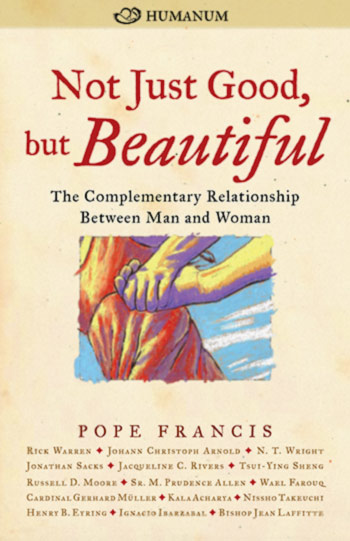Subtotal: $
Checkout-

After Obergefell
-

A Colony of Heaven: The Church in Dissent
-

Pursuing Jesus
-

Digging Deeper: Issue 6
-

Poem: A Fly from the Early Anglers
-

And This Amazing Blue
-

Editors’ Picks Issue 6
-

Featured Books from Plough: Autumn 2015
-

From Khirbet Khizeh to Lod
-

The Witness of Jesus
-

Readers Respond: Issue 6
-

Fundación San Rafael
-

By Sharing We Live
-

Nature through a Child’s Eyes
-

Building the Muscles of Forgiveness
-

Learning to Love Boko Haram
-

Insights on Witness to the Gospel
-

The Upside-Down Church
-

Everyone Belongs to God - a Reading
-

Waiting to be Welcomed
-

Clinic of the Great Physician
-

Equipped with Water, Flip-flops, and Prayer
-

No Time for Silence
-

Marriage under Christ

What Is Marriage For?
Tracing God’s Plan from Genesis to Revelation
By N. T. Wright
September 1, 2017
Available languages: español
Next Article:
Explore Other Articles:
Based on a talk in November 2014, this article – together with essays by Pope Francis, Rick Warren, Rabbi Jonathan Sacks, and others – appears in Not Just Good, but Beautiful: The Complementary Relationship between Man and Woman, edited by Steven Lopes and Helen Alvaré (Plough, September 2015).
One of the fascinating things about the Bible as we now have it – as you know, it was written over rather a long period of time – is that it begins and ends with the coming together of heaven and earth. Right at the beginning of the book of Genesis, we have those two complementary accounts of creation (Genesis chapter 1 and chapter 2, broadly speaking), and from the beginning we are told that God made heaven and earth, and that, so it seems, heaven and earth are supposed to work together. We in the Western world have often thought of heaven and earth as radically separate, as completely distinct. Indeed, some people have constructed whole philosophies in which heaven is so far away that it seems as though it has nothing whatever to do with earth. But in Genesis it’s not like that. Heaven and earth are supposed to be the twin interlocking spheres of God’s good creation.
Then, as the story in Genesis 1 unfolds, we discover that there are all sorts of other things in God’s creation which mirror that, which reflect it, which are likewise supposed to be complementaries. So we have not only heaven and earth; we have the sea and the dry land, we have plants and animals – a different sort of differentiation, but a differentiation nonetheless. Then, within the animal kingdom, we have of course male and female, and indeed also within the plant kingdom up to a point. And then the story reaches its great climax with the creation of human beings in the image of God: male and female together. When we read and re-read this extraordinary account in Genesis 1 (and it is one of the most remarkable pieces of writing from the whole ancient world), then we see that these complementaries all reinforce one another, and are meant to work together, so that the man and the woman together are a symbol of something which is profoundly true of creation as a whole. Not that the man represents heaven and the woman represents earth. That’s a mistake that was made in some ancient paganism. The point, rather, is that the idea of these two being designed to go together, to work together, is a very profound reality at the heart of that whole story of God’s good creation.
 George Tooker, The Tree; Courtesy of DC Moore Gallery, New York.
George Tooker, The Tree; Courtesy of DC Moore Gallery, New York.
Already a subscriber? Sign in
Try 3 months of unlimited access. Start your FREE TRIAL today. Cancel anytime.
Then in Genesis 2 the focus changes and we have a different kind of story, but one which nonetheless also converges on the idea of man and woman coming together, now more explicitly in marriage where one leaves one’s parents and cleaves to one’s spouse, so that the two become one flesh. These two creation stories, which of course are not meant to be photographic reproductions of “what happened at the beginning,” are themselves great symbolic pointers – signposts towards a deeper, stranger reality which human words are probably unable to express. But that’s how symbols work, and that’s how biblical symbols work; and so, right there at the start of the whole Bible as we have it and the start of the book of Genesis, we have this rich symbolic account of God’s good creation in which, at its very heart, the coming together of male plus female is itself a signpost pointing to that great complementarity of God’s whole creation, of heaven and earth belonging together.
When we then jump in a huge sweep to the very end of the Bible – and again, historically speaking, it’s some kind of a providential accident that the book of Revelation is now at the end of the Christian canon of scripture – we find in Revelation 21 and 22 substantially the same thing, only now at the end of the story rather than at the point of its beginning. Indeed, whoever wrote the book of Revelation – Saint John the Divine as he is traditionally called – I think must have known, as he wrote those last two amazing chapters, that this was how the story which began in Genesis was designed to reach its proper conclusion. In his vision, the new Jerusalem is coming down from heaven like a bride adorned for her husband, so that the symbolism of marriage, of male and female coming together (only now it is the church which is the new Jerusalem, coming together with Christ as the bridegroom) – this is the symbol which says that here we find the very heart of God’s intended creation. Heaven and earth were always meant for one another, and now at last that’s what’s going to happen.
Of course, in the Western tradition particularly, we Christians have always thought the name of the game was to leave earth and go to heaven instead, but that’s simply a parody. To be sure, there is much about earth as it is at the moment which is sad, dark, gloomy, and evil. We want to be rid of all that, and to be with God instead. But the whole point of the biblical revelation is that the God who made heaven and earth together in the first place is going to renew them, so that the end of the whole story will not be heaven by itself, but God’s new heaven and new earth. So we shouldn’t be surprised, then, that the symbol for that reality is again marriage, the coming together of the man and the woman, in this case, of Jesus Christ and of his church, as the sign and pointer that this is what God had in mind all along.
Now it’s important to begin with that big picture. If we don’t, we can easily imagine that what the Bible has to say about men and women, about marriage, about all that follows from and surrounds that complicated and rich and exciting topic, is simply a set of rules. We in the Western church have tended to isolate rules from the rest of the picture. We have imagined that the purpose God wants for us is to leave “earth” behind and to go to “heaven” instead, and that God has in the meantime given us these somewhat arbitrary regulations for how he wants us to behave. (Sometimes people say that if we keep the rules we’ll get to heaven; sometimes people say that those who are going to heaven for a different reason, because they believe the gospel, should still keep the rules because that’s what God wants; but in either case there is no organic link between the rules and the ultimate goal.) So people then begin to say, “Well, these ‘rules’ might have been different; we know much better now than people did a long time ago; anyway perhaps the rules were just made up by human teachers who wanted to stop people enjoying themselves…” and so on.
Now that isn’t just a parody of the truth. It is actually a radical distortion of what the Bible is all about. As humans we are called to live as symbols of the heaven-and-earth creation which was given at the beginning and which is to be consummated, as in the book of Revelation, at the end. There are many other passages, in the Bible as a whole and particularly the New Testament, which speak in this rich symbolic way of the purpose of God. Let me give just one or two examples.
At the end of the great chapter we call Romans 8, one of the most extraordinary passages in the whole of the New Testament, we find Paul expounding with delight and almost glee the sense that the whole creation is on tiptoe with expectation because it is going to be set free from its bondage of decay to share the liberty of the glory of the children of God. He is using the imagery of “new birth,” of the new creation being born from the womb of the old. This is a fertile image, a female, birth-giving image. He is treating the picture of a woman giving birth as a signpost, a pointer, to the fact that this is what the whole creation was made for. That reinforces the picture that, from Genesis to Revelation, we have a framework, biblical “bookends” if you like, and when we move in towards the rest of the Bible we see how many other things there mean what they mean within that larger context and framework.
 Lucas Cranach the Elder, Adam and Eve, detail
Lucas Cranach the Elder, Adam and Eve, detail
Already a subscriber? Sign in
Try 3 months of unlimited access. Start your FREE TRIAL today. Cancel anytime.
Obviously a lot of the Old Testament is concerned with the special relationship between God and his people Israel, the people of the family of Abraham. From the very beginning, that is spoken of and imaged in terms of a marriage, a covenant, a partnership: God is like the bridegroom, Israel is like the bride. That corresponds to the very beginning: with Adam and Eve in the garden, there is a purpose. It isn’t just that God and Israel are to be there together, while the rest of creation can do what it likes. When God and Israel get together, this covenant has a purpose, and its purpose is new creation. The whole of the biblical revelation consists of that movement from creation to new creation, from covenant to new covenant. The covenant between God and Israel (and then between Christ and the church, which we’ll come to in a moment), points to, effects, and symbolizes that renewal of all creation.
We shouldn’t be surprised, then, that the New Testament writers pick up that idea of God and Israel and transpose it, translate it, into the language of Christ and the church. This comes out particularly clearly in Paul’s letter to the Ephesians, where in chapter 5 he puts together the advice and counsel to husbands and wives with one of the most stunning and striking pictures of the relationship between Jesus and the people whom he has redeemed. Jesus gives his life for his people; his people respond in gratitude and love. The vocation of husbands and wives is not absolutely identical with this, but it is modeled on it. It symbolizes and points on to the deeper and richer relationship between Christ and the church. That takes us back once more to Revelation, chapters 21 and 22. And in Ephesians, the framework that Paul himself constructs for this teaching includes the telling and crucial introductory comment in chapter 1, that the entire divine purpose always was to sum up all things in heaven and on earth in the Messiah. Then in chapter 2 this is symbolized in the coming together of Jew and Gentile into the one Spirit-filled family; indeed, in chapter 3 Paul speaks of the church as a family with God as its father, before working that out in terms of the unity and holiness of the church in chapters 4 and 5. What he says about husbands and wives in chapter 5 therefore comes within a larger context where in and through Jesus Christ the whole world is brought into a new unity.
That is the larger framework within which we can understand the Bible’s detailed teaching about marriage itself. Here is a point which people often find strange. Frequently folk imagine that the way the Bible works goes like this: the Old Testament is full of rules and regulations, and then the New Testament says, “Don’t worry about those old rules – we don’t believe in law any more. We just live by grace.”
That again is a complete caricature of the way the Bible works. What you actually find in the scriptures is that from the beginning, God’s people have this impetus towards the coming together of one man and one woman in marriage. But Abraham has more than one wife. Isaac is one of the very few patriarchs who, so far as we can tell, have only one. Jacob has two, and then two concubines as well. And by the time we get to David and Solomon we have ancient Near Eastern polygamy in full swing. The biblical writers don’t seem too bothered about that. Of course, David’s adultery is a big problem. And when Solomon takes more foreign wives, that’s a problem too, particularly because they divert his heart from single-minded devotion to the one true God. But though the Old Testament does reiterate the ideal of one man and one woman, this is not a major theme, and some of the great biblical heroes seem to flout it completely.
 Lucas Cranach the Elder, Adam and Eve, detail
Lucas Cranach the Elder, Adam and Eve, detail
Already a subscriber? Sign in
Try 3 months of unlimited access. Start your FREE TRIAL today. Cancel anytime.
But when we get to the New Testament, we find something which goes clean against the assumption I mentioned a moment ago. We might expect, from the received assumption, that we would move from a strict moral demand in the Old Testament to a slackening of moral tension in the New. Not a bit of it. Jesus is very clear, in Mark 10 and elsewhere: now that he is there, launching God’s kingdom, renewing the covenant between God and his people, the creation itself is being renewed. He goes back to the beginning, to Genesis 1 and 2: God made them male and female, and insisted that the two would become one.
This was, to say the least, unexpected. Jesus’ first followers were puzzled, as many are today, by the clear and strict simplicity of what he says. His own disciples asked him how it would work out, and Jesus explained that from the beginning this was how God planned it. He grants that, in Deuteronomy, Moses gave permission for divorce. But this, he says, was because of “the hardness of your hearts.” That is one of many places in the gospel story where it seems that Jesus is hinting or implying that what is on offer in his message is a cure for the hardness of human hearts. That is a huge challenge, as much today as it was in Jesus’ day. It takes a lot of pastoral working out. These are difficult and dark areas where many people struggle today, as they have always done.
But that is the picture, and that’s why it means what it means. It isn’t that Jesus is saying, “Here is an absolute demand, and if you can’t make it, then God can’t love you.” He is saying, “Here is the way humans were meant to be, and if you follow me we’ll make it a reality.” Actually, humans know in their bones that this is how we were meant to be. And what we all half-know (though we become skilled at covering up this knowledge), God gives in the new creation of the gospel. In this area, as in all others, we cannot achieve it in our own strength. We are invited to take it as a gift.
As we do so, and then follow that through the teaching about man and woman which we find in the rest of the New Testament, we discover again and again that it isn’t just an odd rule, a rule which we might in our day object to on the basis that we have new and different scientific knowledge about how human beings actually are. It is always a statement of faith about the meaning of God’s creation and about God’s ultimate purposes for that creation.
Of course in our day we have had the prevailing mood of modern Western secularism. This goes back to a long tradition first of Deism, and then actually to a modern version of ancient Epicureanism. This gives people the idea that if there is a heaven, if there is a God, they are so far away as to be for all practical purposes irrelevant, so we might as well treat them as nonexistent. So people in the Western world have lived with an implicit worldview which says, “Religion is about escaping earth and getting to heaven.” Then the “realists,” who think of themselves as having their feet firmly on the earth, don’t want to have anything to do with heaven or God at all.
We have inhaled the air of philosophies like that for so long that we shouldn’t be surprised to find ourselves, in our cultures and our societies, symbolizing something of the same in our human relationships. Split heaven and earth apart and you will split other things apart as well, one of them being marriage. That is one of many reasons why, today, many people both inside and outside the church find the biblical norm, the new-creation, new-covenant ideal of husband and wife, so hard to maintain. It is indeed something many of us have to work hard at. It’s tough being a Christian in today’s world. It’s tough being a husband or a wife; it’s tough making family life work. But that is because it is a sign and a symbol of the most extraordinary divine plan, the plan which cost God himself the death of his own beloved son. That is how God brought heaven and earth together: the death and resurrection of Jesus, nothing less. And that has to be worked out in every area of Christian faithfulness.
This shouldn’t surprise us. Jesus himself, and every great teacher of the faith, made it clear. To follow him means taking up the cross. It costs us the equivalent of the cross, in the moral struggle through which we fulfill our calling in baptism: to die daily, to be generous, to be wise, to be humble, to be forgiving, to be patient, to be loving; to be, in other words, whole human beings. Marriage, the coming together of one man and one woman, is the context within which so much of that is symbolized and actualized.
That is why, I believe, the biblical picture of man and woman together in marriage is not something about which we can say, “Oh well, they had some funny ideas back then. We know better now.” The biblical view of marriage is part of the larger whole of new creation, and it symbolizes and points to that divine plan. Every time I, as a priest, celebrate the marriage of a couple, I remind myself, and I frequently remind the couple, that what we are doing is setting up a signpost. We live in a world of many storms and many winds; those signposts can easily get battered and broken. But they are pointing somewhere – and the reality to which they are pointing is the fulfillment of God’s good purposes for creation.
Marriage is a sign of all things in heaven and on earth coming together in Christ. That’s why it is a tough calling. But that is why, also, it is central and non-negotiable. That, for me, is what it’s all about.
Already a subscriber? Sign in
Try 3 months of unlimited access. Start your FREE TRIAL today. Cancel anytime.



































